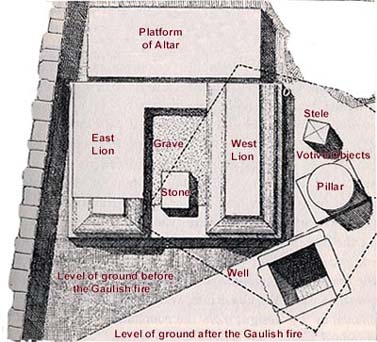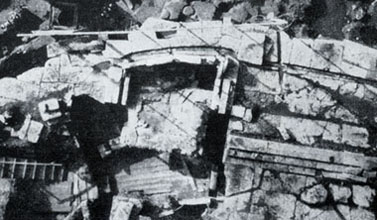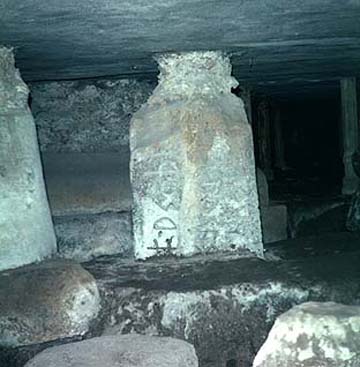At the south of the Comitium a rectangular slab of dark marble
was discovered in January of 1899. Marked as "stone"
on the drawing just below, it measures 4x3 meters, and is 1/4
to 1/3 of a meter in thickness. Festus (177) refers to this as
the lapis niger, or "black stone." 
The picture below is an aerial photograph of the site taken
about one year after those first excavations.

Excavation beneath the stone in the spring of 1899 revealed
a group of three monuments: a tufa cone, a sacellum, and,
pictured below, a four-sided stele, inscribed on all sides:

This inscription appears to be a ritual law, but examination of the inscription baffled scholars during the first years after the find, until eventually the text was reconstructed. The Latin text is now designated as ILS 4913 (CIL 6.36840), translation as follows:
Whosoever defiles this spot, let him be forfeit to the
spirits of the underworld; whosoever contaminates it with refuse,
after due process of law, it shall be proper for the King to
deprive him of his property. And whatsoever persons the King
shall discover passing on this road, let him bid the Herald seize
the reins of their draught animals, to force them to turn aside
forthwith and to take the approved detour. And whosoever shall
fail to take the approved detour and shall persist in traveling
this road, let him after due process of law be sold at auction
to the highest bidder.
The Comitium itself (Tacitus Ann.13.58; Livy 24.20.6), and the area of the Lapis Niger has a strong association with the cult of Romulus, the legendary founder and first King of Rome. In the late Republic, tradition held that the 'black stone' was the very marker for the tomb of Romulus. Competing tradition held that it was rather the tomb of Hostilius, grandfather of Rome's third king, Tullius Hostilius.
For many, the question of the tomb's identity was closed by a second major excavation in 1955 which failed to find any trace of a tomb beneath the lapis niger.